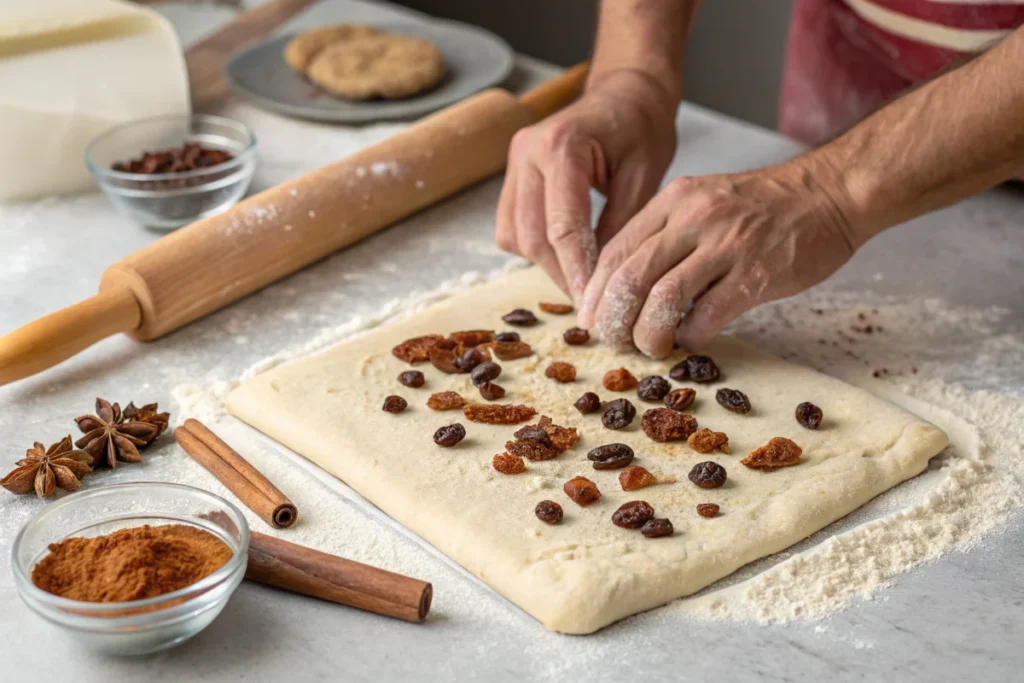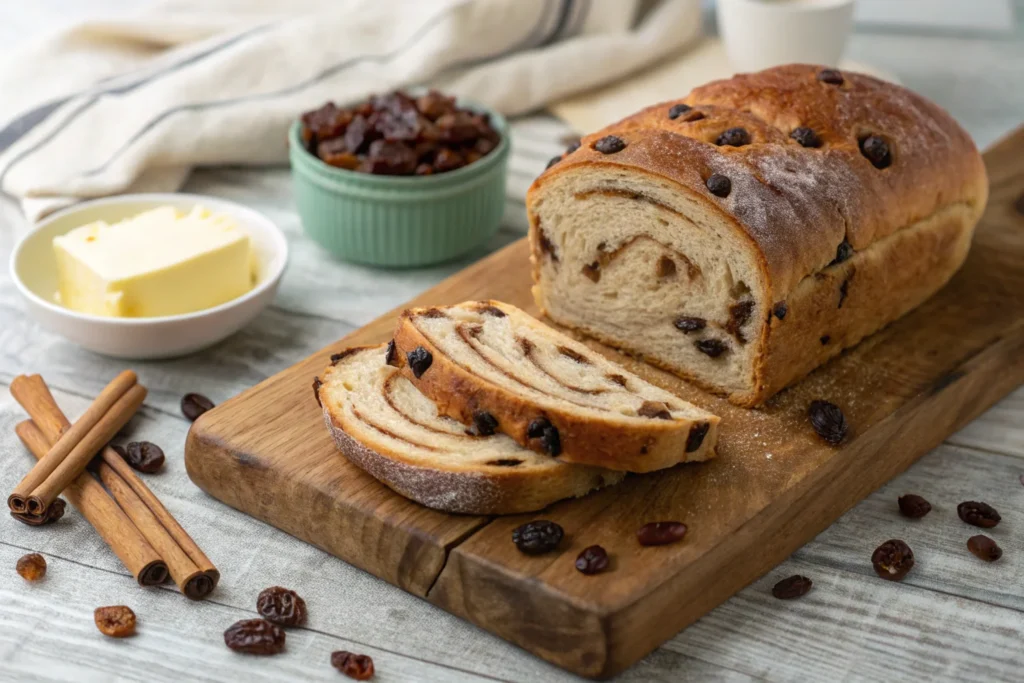Cinnamon raisin sourdough bread tantalizes the senses with its warm aroma and sweet, subtle tang. From its soft crumb to the delightful swirl of cinnamon, each slice whispers comfort. Many home bakers crave the timeless flavor combination of cinnamon and raisins in a handcrafted sourdough loaf. Yet, they may hesitate due to perceived complexity. However, baking this bread can be simpler than you think.
In this guide, you will learn every detail needed to create the perfect cinnamon raisin sourdough bread. You will discover how to select quality ingredients, master essential fermentation principles, and optimize your baking process for consistent success. Read on to find out why cinnamon raisin sourdough bread deserves a permanent place in your recipe repertoire.
Why Cinnamon Raisin Sourdough Bread Is Irresistible
Cinnamon raisin sourdough bread stands out for its balance of flavor and texture. The tang of sourdough merges with the sweetness of raisins. Then, the bold essence of cinnamon amplifies the entire experience. Moreover, sourdough fermentation boosts digestibility and creates a hearty, nourishing crumb.
A Timeless Flavor Combination
Raisins lend a natural sweetness that contrasts beautifully with sourdough’s gentle acidity. Meanwhile, cinnamon adds a warm, spicy touch. Together, these flavors appeal to a wide audience:
- Families looking for an elevated breakfast toast.
- Home bakers seeking a sweet-savory crossover loaf.
- Artisan bread enthusiasts wanting a classic yet flavorful recipe.
Aroma That Captures Attention
The moment you slide cinnamon raisin sourdough bread into the oven, your kitchen transforms. Aromas of warm spice and toasty dough swirl together. As the loaf bakes, the crust caramelizes slightly. This results in a golden-brown exterior that holds the promise of a soft, fragrant interior.
However, taste isn’t the only reason this loaf is irresistible. The fermented dough is kinder to sensitive stomachs. As you read on, you will see how the sourdough process changes the nutritional profile of bread. That alone makes it a worthwhile baking project.
Key Ingredients for Cinnamon Raisin Sourdough Bread
Your choice of ingredients influences the final flavor, crumb, and color. Therefore, it pays to pick each component thoughtfully. Below are the primary elements that bring cinnamon raisin sourdough bread to life.
- Active Sourdough Starter
A healthy, bubbly starter is the heart of any sourdough. Feed it regularly to ensure peak activity. This leads to an airy crumb and noticeable tang. - High-Quality Flour
Many bakers prefer a blend of bread flour and whole wheat flour. Bread flour’s strong gluten content supports structure. Whole wheat contributes depth of flavor and nutritional benefits. - Filtered Water
Unwanted chemicals can affect fermentation. Filtered water helps maintain consistent dough hydration and flavor. - Salt
Just enough salt enhances taste. Without it, your bread might taste flat. - Cinnamon
This star ingredient is crucial. Use a good-quality ground cinnamon for pronounced aroma. - Raisins
Plump, soft raisins blend seamlessly into the dough. If your raisins feel dry, soak them in warm water before mixing.
Choosing the Right Flour for Your Sourdough
Flour determines the bread’s structure. Bread flour has higher protein content, which promotes gluten development. Strong gluten gives the loaf its characteristic shape and chew. Whole wheat flour, on the other hand, adds earthy depth.
For cinnamon raisin sourdough bread, you can stick to 100% bread flour. Yet, many bakers incorporate a small portion of whole wheat flour for flavor complexity. If you prefer a lighter crumb, use no more than 20% whole wheat in the flour blend.
The Star Ingredient: Cinnamon’s Role in Raisin Sourdough
Cinnamon does more than just add flavor. It also impacts dough structure, although minimally. When mixed properly and at the right stage, cinnamon integrates evenly. That way, every bite contains that warm, slightly sweet spice. However, excessive cinnamon might slow yeast growth. Therefore, the right balance is key.
Essential Tools and Equipment
Baking cinnamon raisin sourdough bread requires a few essential tools. Acquiring these items can streamline the process and boost your chance of success.
- Digital Kitchen Scale: Weigh ingredients precisely for consistent results.
- Mixing Bowls: Choose medium and large bowls to accommodate dough expansion.
- Bench Scraper: Helps with folding and shaping.
- Dough Whisk or Wooden Spoon: Mix dough without overworking it.
- Proofing Basket (Banneton): Provides structure during the final rise.
- Dutch Oven or Baking Stone: Retains heat and promotes even baking.
- Thermometer: Check dough temperature and final baked loaf temperature (should reach about 200°F internally).
Proper Mixing and Kneading Techniques
Proper mixing promotes gluten formation. When gluten is strong, your loaf can rise without collapsing. Sourdough often relies on a gentle process called the “stretch and fold” method:
- Combine Flour, Water, and Starter: Mix just until combined.
- Autolyse: Let dough rest for 30 minutes to 1 hour. This improves texture.
- Add Salt: Incorporate salt after autolyse.
- Stretch and Fold: Perform this every 30 minutes for about 2 hours. Each set of folds strengthens the dough.
This technique ensures minimal effort. Yet it offers maximum gluten development. Kneading on a floured surface is another option, but be wary of adding too much flour. Too much flour can dry out the dough.
Step-by-Step Process for Making Cinnamon Raisin Sourdough Bread
Now that you have an overview of ingredients and equipment, it’s time to dive into specifics. The process might seem lengthy. However, each phase builds the bread’s structure and flavor.
- Feed Your Starter
Start with a mature sourdough starter that’s been fed 8 to 12 hours before. It should appear bubbly and active. - Measure Your Ingredients
Use a digital scale. Precision matters for consistent hydration and fermentation. - Autolyse
Combine your flour and water. Let the mixture sit to hydrate the flour. This step typically lasts 30 minutes to an hour. - Mix in Starter and Salt
Add your sourdough starter first. After it’s incorporated, add salt. Next, perform gentle folds until the dough appears cohesive. - Stretch and Fold
Every 30 minutes for the next 2 hours, perform stretch-and-fold sets. This method strengthens the gluten network. - Add Cinnamon and Raisins
Incorporate cinnamon after the gluten has developed a bit. Fold in raisins after your dough appears elastic and structured.
Hydration and Dough Preparation
Hydration level matters greatly. It influences how airy or dense your loaf becomes. High-hydration dough (70% or more) yields a more open crumb. However, it can be trickier to handle. For cinnamon raisin sourdough bread, aim for a hydration between 65% and 70%. This range accommodates the extra dry ingredients (cinnamon and raisins) without resulting in an overly sticky dough.
- If the dough feels too sticky: Add a light sprinkle of flour while folding.
- If the dough feels too stiff: Lightly moisten your hands and continue stretching.
The Proofing Phase
The first proof, or bulk fermentation, typically lasts 4 to 6 hours at room temperature. Temperature greatly impacts the timing. Warmer temperatures speed fermentation, while cooler ones slow it. Look for a noticeable increase in dough volume. However, do not let it double completely if you desire a pronounced sourdough tang. Overproofing can yield a collapsed loaf.

Shaping and Baking Your Cinnamon Raisin Sourdough Bread
Once bulk fermentation is complete, move on to shaping. Shaping controls the final appearance of your loaf. For cinnamon raisin sourdough bread, you might want to incorporate a swirl of cinnamon inside. Alternatively, you can keep the dough uniform by evenly mixing the cinnamon throughout.
Creating the Swirl and Adding Raisins
For a distinct swirl:
- Lightly Flatten the Dough: Dust your work surface with flour. Gently press the dough into a rectangle.
- Sprinkle Cinnamon: Apply an even layer. Some bakers also spread a thin layer of softened butter.
- Distribute Raisins: Scatter raisins across the dough.
- Roll Tightly: Starting from one end, roll the dough into a log. Pinch the seams to seal.
This method ensures a beautiful spiral pattern once you slice into your baked loaf. However, if you prefer fewer visible layers, simply fold the raisins and cinnamon evenly into the dough during mixing.
Achieving the Perfect Bake
Baking techniques influence the final color, rise, and crust. A Dutch oven is popular because it traps steam. Steam helps the loaf expand before the crust hardens. You can also use a baking stone with a steam pan in your oven.
- Preheat Your Oven: Aim for 450°F (230°C). Preheating for about 30 minutes ensures even heat distribution.
- Transfer the Loaf: Place your shaped dough into the Dutch oven (or onto a baking stone).
- Score the Loaf: Use a sharp blade to slash the top. Scoring directs the loaf’s expansion during oven spring.
- Bake with Steam: Cover the Dutch oven or add a steam pan for the first 20 minutes.
- Uncover: Remove the lid and bake for another 20 to 25 minutes at 425°F (218°C). Look for a golden crust.
- Check Internal Temperature: The loaf is done when it reaches about 200°F (93°C).
Remove the loaf from the oven and cool it on a wire rack. Allow at least one hour before slicing, to let the crumb set. Although the aroma might be irresistible, cutting too soon could ruin the structure.
Common Mistakes to Avoid
Even experienced bakers face hiccups. However, you can steer clear of common pitfalls by understanding these frequent missteps.
- Adding Cinnamon Too Early: Cinnamon can inhibit yeast activity. Wait until gluten has formed.
- Overloading on Raisins: Too many raisins weigh down the dough. Use a balanced amount.
- Skipping the Autolyse: This rest period greatly improves dough texture.
- Inconsistent Starter Maintenance: A weak starter leads to inadequate rise. Feed your starter on schedule.
- Impatience with Proofing: Underproofing or overproofing both hamper rise. Watch the dough’s volume, not just the clock.
If you keep these points in mind, you will minimize errors and produce a consistent loaf. Therefore, your journey toward a perfect cinnamon raisin sourdough bread will be less stressful.

Delicious Serving Suggestions
Once your cinnamon raisin sourdough bread emerges golden and fragrant, the fun truly begins. You can enjoy it straight from the oven or explore creative ways to showcase its flavor.
- Classic Toast
Toast slices lightly and slather them with butter or cream cheese. The swirl pattern looks stunning when toasted. - French Toast or Bread Pudding
Transform leftover slices into a comforting brunch dish. The inherent sweetness of cinnamon raisin sourdough bread pairs beautifully with maple syrup. - Sandwiches
Although it’s sweet, you can still create savory sandwiches. For example, pair slices with turkey, brie, and a cranberry spread. - Cheese Board Companion
Add it to a cheese board. Sharp cheeses, honey, and fruit complement the raisin-cinnamon profile.
Pairing Cinnamon Raisin Sourdough with Sweet or Savory Toppings
- Sweet Toppings:
- Honey and ricotta
- Nut butter and fresh berries
- Mascarpone and a sprinkle of cinnamon sugar
- Savory Toppings:
- Aged cheddar and fig jam
- Melted brie and crisp bacon
- Goat cheese and caramelized onions
Experimenting with toppings keeps your bread experience fresh. However, there is something uniquely satisfying about slicing into a plain, freshly baked loaf and enjoying it unadorned.
Health Benefits and Nutritional Value
Sourdough bread differs from regular yeasted bread due to its fermentation process. Bacteria in the starter break down some of the proteins in flour, making them easier to digest. Meanwhile, cinnamon itself contains antioxidants. Together, these factors make cinnamon raisin sourdough bread a nutritious treat.
Why Sourdough Fermentation Aids Digestion
During fermentation, lactobacilli produce lactic acid. This acid partially breaks down gluten, which can lead to better nutrient availability and easier digestion. For many, sourdough products feel gentler on the stomach. For instance, those who experience minor gluten sensitivities often find sourdough more tolerable than traditional bread.
- Lower Glycemic Index: Sourdough tends to have a more stable effect on blood sugar.
- Mineral Availability: Fermentation can reduce phytic acid, which interferes with mineral absorption.
Cinnamon’s Impact on Blood Sugar Levels
Cinnamon may help with blood sugar regulation. Though not a miracle cure, it can modestly reduce insulin resistance. When combined with the moderate glycemic impact of sourdough, this bread offers a more balanced option than many sweet breads on the market.
Still, moderation is key. Cinnamon raisin sourdough bread contains sugar from raisins, so you should enjoy it as part of a balanced diet.
FAQ: All About Cinnamon Raisin Sourdough Bread
Below, you’ll find answers to common questions about cinnamon raisin sourdough bread. These questions often appear in the “People Also Ask” section online, and they shed light on the finer points of baking and flavor interactions.
Does cinnamon affect sourdough?
Cinnamon can mildly inhibit yeast activity. Therefore, adding it too early in the mixing process may slow fermentation. However, a moderate amount of cinnamon, introduced after gluten forms, has minimal negative impact on your dough’s rise.
Why is sourdough bread not fattening?
Sourdough bread is often considered less fattening because of its beneficial fermentation process. Fermentation can reduce the glycemic impact and improve nutrient absorption. Nonetheless, portion control and a balanced diet remain essential for weight management.
Does cinnamon affect dough rise?
When used in moderation, cinnamon won’t significantly harm your dough rise. It can slow yeast development if overused or added prematurely. However, when incorporated properly, your dough should rise as expected.
Why is cinnamon raisin bread so good?
Cinnamon raisin bread is beloved for its comforting sweetness and aromatic qualities. The natural sugars in raisins contrast with the spice of cinnamon, creating a balanced flavor. When made with sourdough, it offers additional tanginess and improved digestibility.
Conclusion
Cinnamon raisin sourdough bread merges tradition, flavor, and nutrition in a single loaf. You benefit from the gut-friendly properties of sourdough fermentation and the warm spice of cinnamon. Meanwhile, raisins add natural sweetness that elevates each slice. Although this loaf demands patience, the reward is clear in its distinctive aroma and taste.
From selecting the best flour to mastering fermentation, every step in the process builds your confidence as a home baker. With a bit of practice, you’ll refine your technique and adapt the recipe to your preferences. Therefore, you can create a signature version of cinnamon raisin sourdough bread that brings comfort and joy to everyone who tastes it.
Bake boldly, and don’t hesitate to experiment with variations. Over time, your sense of timing and dough handling will improve. Soon, you’ll produce loaves that rival those of your favorite bakery. Enjoy the timeless delight of homemade cinnamon raisin sourdough bread and share it with those you love.

